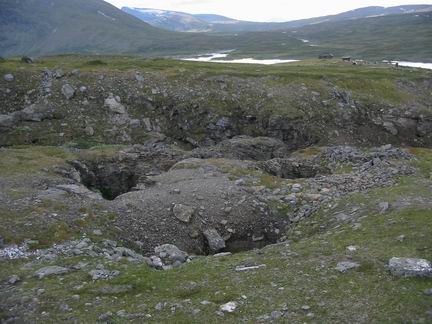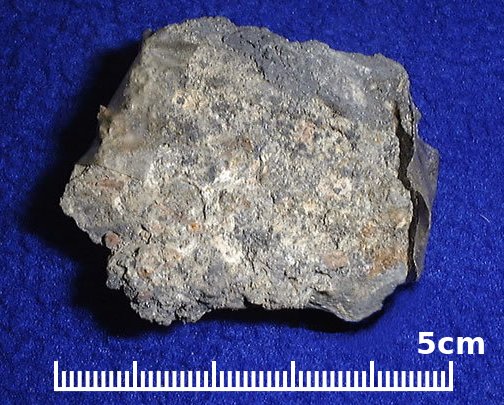This
Earthcache is concerned with the quite extensive silver mining that
took place during the 17th and 18th century in today´s Laponia area
and the importance of the silver smeltering for the area. The
village of Kvikkjokk was founded as a result of these activities
and here also the smelter works were located that processed the
mined silver.
Silver Mining History in Laponia
During the 17th century, Sweden was looking for funding sources to
pay their involvement in the Thirty Years War, in which they
participated between 1630 and 1648. The silver ore discoveries in
Laponia and the hope of high profit came to the right time for the
government, also because it was more and more interested in the
Laponia area. In the end, the profit from the silver mining was
very low and quickly turned into losses. One side effect of the
mining activities was the proselytization of the sami people by the
Church. Colonisation and proselytization happened largely in line
with displacement, land theft, and maximizing the profit. Today,
silver mining is not considered economic, but other mineral riches
have been found in the Laponia area, in particular iron ore, which
is mined in Kiruna and Gällivare.

Alkavare Silver Mining
Site as it looks
today
Laponian Silver
Ore

Sample of Silver Ore
Silver
is found in native form, as an alloy with gold, and in ores
containing sulphur, arsenic, antimony or chlorine. Ores include
argentite (Ag2S), chlorargyrite (AgCl) which includes
horn silver, and pyrargyrite
(Ag3SbS3). The principal sources of silver
are the ores of copper, copper-nickel, lead, and lead-zinc. In
Laponia, the silver is contained within lead ore, which makes it
necessary to separate the two in order to obtain relatively pure
silver. This process took place in the smelter in Kvikkjokk.
The lead reduction smelting process involves the separation of
silver from the lead in an oxygen-rich environment. High
temperatures and
excess carbon are indispensable for silver smelting. In a furnace
fired by natural gas, the heat source provides no excess carbon to
bond the oxygen. The fusion will not succeed if there is
insufficient carbon available. The way around this is to add a
carbon source to the fluxes.
In former times, coal or charcoal was placed inside the crucible.
Before the lead can be removed from the silver, all additional
components that are present in the ore have to be removed. The lead
has a special property itself. Liquid lead is an extremely
efficient scavenger of other metals, especially silver and gold. As
the melted lead trickles through the molten slag, it picks up noble
metals in its downward path to the bottom of the furnace or
crucible, stripping the slag of its metal content. The combination
of heat and high-carbon insures all the oxides, sulfides and
silicates in the mix are chemically reduced. If a
reducing environment is not achieved in the mix of ore and fluxes,
then the lead would oxidize to litharge, preventing it from
scavenging noble metals from the slag. During the fusion, as the
lead and precious metals sink to the bottom, the less dense slag
floats on top. The final step of the smeltering process is the
separation of lead and silver. In a furnace whose contents can be
isolated from sources of carbon, the buttons and cakes of
argentiferrous lead are placed in porous containers called cupels,
or placed on a thick porous
"cupellation" hearth, respectively. The cupels and the porous
hearth are made of ashes mixed with water and compacted. The ashes
are sometimes mixed with other materials in order to improve
cohesion or hardness in the cupels or hearth. Once the furnace is
up to temperature
(~900 C),
the argentiferrous lead is placed in a cupel or on the
cupellation
hearth. Since lead is a base metal, in the presence of heat
and
oxygen (but not carbon), it will oxidize to red or yellow litharge.
This litharge will be in the liquid state due to the elevated
temperature of the furnace, and will be adsorbed by the porous
cupel or hearth. The temperatures needed to melt lead and litharge
are not sufficient to melt silver. When all the lead is converted
to PbO and
adsorbed by the cupel, the only solid left in the cupel or on the
cupellation hearth is the silver. The mining term for the round bit
of precious metal left at the end of cupellation is a
dore.
From the above, it can bee seen that the process of obtaining
silver from the lead ores of Laponia was not easy.
Silver Mining near
Kvikkjokk
In the
middle of the 16th century, silver ore was discovered in the
vicinity of Kvikkjokk, namely in Alkavare (Alggavarre)
andKedkevare
(Silpatjakko),
both located within today´s SareksNationalpark.
1661, a silver smelter was built in Kvikkjokk, since here
there
was access to the two important resources lumber and water
(power).
Transport of the ore from the mines to Kvikkjokk and the processed
silver from Kvikkjokk to the harbour in Luleå was executed by the
sami people. At high times, over 100 men were working in the
Kvikkjokk silver mines and smelters. Many of those where miners
from the coastal region, drawn here with the promise of liberation
from military service. Some works required well educated
specialists, which mostly came from Germany. Despite all the
investments and the effort,
the production was low and only a few kilograms of silver were
produced every year from the ore, leading to economic losses. In
total, the ore mining in the mines of Alkavare (Alggavarre)
and Kedkevare (Silpatjakko)
lasted from 1659 to 1702. While
mining was
unsuccessfull,
it caused Kvikkjokk to become a civic centre at this time. A church
was built here and in 1696 Kvikkjokk became a place of importance
in the congregation of Jokkmokk. Today, one of the oldest historic
artifacts from this time is a map from 1661, showing the
founding and development of the silver mining company.
Now for the
questions:
1) Which river was most likely used as a source of water power to
run the smelters?
2) The ore was transported from the Alkavare (Álggavárre) and
Kedkevare (Silpatjåkko) mines to Kvikkjokk. Find out the location
(coordinates) of these two mines and explain for both mines, which
was the best way (geographically and physically) to transport the
ore to Kvikkjokk. Also, please desribe in your own word the
difficulties of such transport.
3) At the cache coordinates, you find a sign pointing to a point of
interest of the silver smelting in Kvikkjokk. What is this point of
interest?
4) Please make a photo of yourself/your GPS at the cache
coordinates. [This is an optional task, but for the means of
fairness, should be honored].
----------------
SWENSKA
Denna
earthcache handlar om den storskaliga brytningen av silver som
skedde under 1700- och 1800-talet i Lappland och
silverbrytningens betydelse för detta
område. Byn Kvikkjokk grundades som ett resultat av denna aktivitet
då det var här smältverken som bearbetade silvret
förlades.
Silverbrytningens historia i Lappland
Under
1700-talet letade svenska staten efter nya inkomstkällor för att
finansiera sin insats i det 30-åriga kriget som de deltog i 1630
till 1648. Silverfyndigheterna i Lappland kom därför lägligt för
den svenska staten som betraktade landet i norr som Sveriges koloni
vars rikedomar i möjligaste mån skulle utnyttjas. I längden gav
inte silverbrytningen någon god avkastning och brytningen blev
därför snart en förlustaffär. Silverbrytningen användes även som en
förevändning att sprida Guds ord i lappmarken. Idag anses inte
silverbrytning i Lappland vara lönsam men andra mineraler, i
synnerhet järn, bryts i Kiruna och Gällivare.

Gruvområdet i Alkavare (Álggavárre) som det ser ut
idag.
Lappländsk silvermalm

Silvermalm
I
naturen förekommer silver dels som blandkristall med guld, dels i
förening med svavel, arsenik, antimon och klor. Typiska mineraler
är silverglans (Ag2S), proustit
(Ag3AsS3), pyrargyrit
(Ag3SbS3) och klorargyrit (AgCl). De
huvudsakliga källorna av silver är koppar- och blymalm. I Lappland
hittades silver främst i blymalm. Ett smältverk uppfördes i
Kvikkjokk där blymalmen bearbetades för att separera silvret från
blyet. Utvinningen av silver bestod av två processer, smältning och
separering. I smältningsprocessen smältes krossad blymalm ned i en
ugn under hög temperatur tillsammans med träkol för att erhålla ett
så kallat silverhaltigt verkbly. Bly har en förmåga att binda till
sig ädelmetaller såsom silver varför bly eller blymalm tillsattes
till malmen om inte malmen i sig redan var blyhaltig. Det var
viktigt att smältningen skedde under reducerande förhållande så att
blyet inte oxiderade till blyoxid i stället för att binda till sig
silvret. Träkol tillsattes därför under smältningen så att det
ständigt fanns ett överskott av kol som kontinuerligt reducerade
oxider, sulfider och silikater som förekom i malmen. Under
smältningsprocessen sjönk blyet och silvret till botten av ugnen
medan övriga ämnen i malmen som har en lägre densitet lade sig på
ytan. Restprodukterna vid ytan, även kallad för slagg, tappades
därefter av och kvar fanns det silverhaltiga verkblyet som tappades
i gjutformer. Ur verkblyet separerades därefter blyet från silvret
i en avdrivningsugn med den så kallade avdrivningsmetoden. Under
hög temperatur, ca 1000°C, och syrerik miljö oxideras bly till
blyoxid. Vid denna temperatur är blyoxiden till skillnad från
silvret flytande och kan tappas av. Efter en till tre dagar
återstår endast en tunn hinna av blyoxid över silvret. När denna
hinna brister och silverytan tittar fram är oxidationen avslutad
och man säger att ”silvret blickar”.
Silverbrytning i närheten av Kvikkjokk
I
mitten på 1600-talet upptäcktes silverfyndigheter i Alkavare
(Álggavárre) och Kedkevare (Silpatjåkko) som ligger i vad som idag
är Sareks nationalpark. 1661 byggdes ett smältverk i Kvikkjokk eftersom där fanns tillgång till två
viktiga resurser: trä och vatten (vattenkraft). Det var samer som
transporterade malmen från gruvorna till Kvikkjokk och det
bearbetade silvret från Kvikkjokk till hamnen i Luleå. Som mest
arbetade över 100 människor i silvergruvorna och i silverbruket i
Kvikkjokk. Flertalet av gruvarbetarna kom från samhällen utmed
kusten som kommit dit med löfte att slippa militärtjänstgöring. En
del av arbetet krävde specialistkompetens, varför tyska bergsmän
anlitades. Trots alla investeringar och envetna försök var
produktionen mycket låg. Endast ett par kilogram av silver
framställdes varje år vilket ledde till ekonomiska förluster.
Sammanlagt pågick silverbrytningen i Alkavare (Álggavárre) och
Kedkevare (Silpatjåkko) från 1659 till 1702. Även om gruvbrytningen
inte var en större framgång bidrog det till att Kvikkjokk blev en
central ort vid denna tidpunkt. En
kyrka uppfördes där och 1696 blev Kvikkjokk en viktig plats för den
kyrkliga församlingen i Jokkmokk. En karta från 1661 visar
grundandet och utvecklingen av företaget för
silverbrytningen.
Nu till frågorna:
1)
Vilket älv
användes troligtvis som vattenkraft för att driva
smältverken?
2)
Malmen
transporterades från gruvorna i Alkavare (Álggavárre) och Kedkevare
(Silpatjåkko) till Kvikkjokk. Hitta var dessa gruvor var placerade
(koordinaterna) och förklara vilken väg som lämpade sig bäst (såväl
geografiskt som fysiskt) för att transportera malmen till Kvikkjokk
från gruvorna. Beskriv även med egna ord svårigheterna med en sådan
transport.
3)
Vid
koordinaterna för cachen finns det en skylt som visar på något som
är av intresse för silversmältningen i Kvikkjokk. Vad är
detta?
4)
Vänligen ta
ett foto av dig själv/din GPS vid cachekoordinaten. [Detta är inte
obligatoriskt men uppskattas]